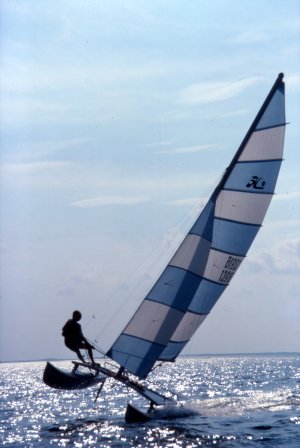
Catamaran Sailing at Shell Point
by Don Draughon
|
You tighten up on the main sheet and bear off slightly from the wind. The boat picks up speed and the hull your sitting on starts to lift out of the water. You’re quickly leaving the beach with all of its noise behind you and all you hear is the wind, the water rushing past the hulls and the rigging straining under the pressure of the wind. You hook the harness you’re wearing into the trapeze wire and scramble backwards till your standing, feet spread, on the side of the boat. Taking a double wrap on the mainsheet line you haul it in as tight as it will go while bearing off further from the wind. The boat picks up more speed and the hull your standing on lifts further out of the water. You’re going real fast now, about 20 knots, the salt water spray is hitting you in the face and it feels good. Looking back at the beach the people look like ants and you can barely make out your umbrella. The small inshore waves now give way to the larger swells as you race further out to sea. You feel a sudden gust of wind and the boat starts to go over. You’re standing almost vertical with the whole boat beneath you about to capsize. Everything slows down now and you’re not sure if you’re going over or not. Arching your back while steering her up into the wind the boat slowly settles back down. This causes you and the windward hull you’re standing on to slam into the water. At this point you’re completely drenched but the boat is still upright, you’re still connected to it and you haven’t lost your hat or sunglasses. So you quickly bend your knees to bring yourself closer to the boat restoring the center of gravity and again steer her away from the wind to regain some speed. Once again your underway, the windward hull rises out of the water, you’re back out on the trapeze “flying the hull”. Now as the water gets deeper the ocean swells are further apart and bigger, maybe six to eight feet high. The swells are headed towards shore and you’re headed out, the boat glides over them with ease, taking each one at an angle so as not to be blown backwards. You make adjustments and look up at the telltales on the sails and see that they are all streaming against the sails on both sides. This means your getting all the speed you can from the boat. As you reach the peak of each swell you and the boat become airborne for just a second or two then landing in the trough only to climb the next swell and do it again. It’s like a big roller coaster ride with no motor, only you, the boat and the wind. You’re really hauling ass, and you’re airborne at times, literally flying! You can’t help but to let out a big Rebel yell even though there’s no one to hear it. You’re several miles offshore now, Alligator Point is visible off to your west and you can barely make out the St. Marks lighthouse to the east but Shell Point beach has almost disappeared behind you. So you decide it’s time to turn back. Coming about in high seas with lots of wind is always tricky on a catamaran. But you manage it successfully then jibe the boat so that now you’re headed downwind back to the beach at Shell Point. Now that you’re sailing downwind you don’t feel the wind as much since its going in roughly the same direction as you are. And the swells are too, so they gently push you along and occasionally you surf down the face of one before it passes under you. So the ride back is very relaxing compared to the ride out but you’re still moving along at a good clip. Approaching the beach you scan the coastline for landmarks and finally spot your beach umbrella. As you make your final approach the shallow water causes your rudders to kick up and just before making landfall you swing the boat around and point her into the wind. You pop the sheets and the sails begin to flutter aimlessly in the breeze. You jump off and pull the boat backwards onto the beach. Now its time to relax and drink a beer.
|
Other web sites by Don you might want to visit:
Don Draughon's